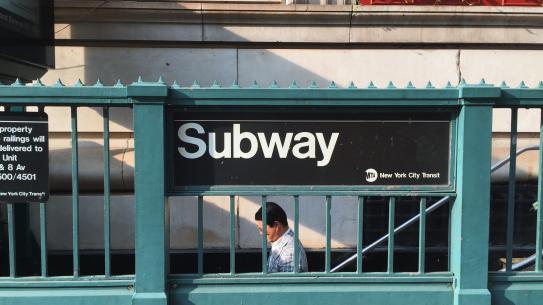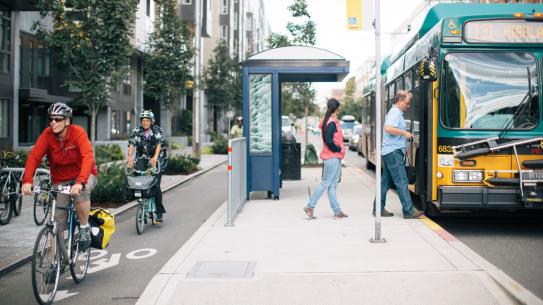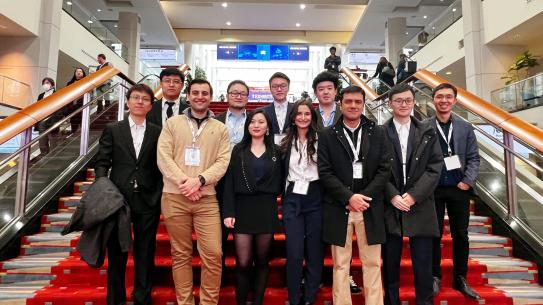Kaan Ozbay
,
Ph.D.
-
Professor and Director of C2SMART

Kaan M.A. Özbay joined Department of Civil and Urban Engineering and Center for Urban Science and Progress (CUSP) at NYU in August 2013. Since 2017, Professor Ozbay has been the Founding Director of the C2SMART Center (Tier 1 UTC funded by USDOT). He is also Global Network Professor of Civil and Urban Engineering, NYU Abu Dhabi (NYUAD) and Global Network Professor of Engineering and Computer Science, NYU Shanghai (NYUSH). Professor Ozbay was a tenured full Professor at the Rutgers University Department of Civil and Environmental Engineering. He joined Rutgers University as a tenure track Assistant Professor in July, 1996. In 2008, he was a visiting scholar at the Operations Research and Financial Engineering (ORFE) Department of Princeton University.
Dr. Ozbay is the recipient of the prestigious National Science Foundation (NSF) CAREER award. Dr. Ozbay is the co-editor of an edited book titled “Dynamic Traffic Control & Guidance” published by Springer Verlag’s "Complex Social, Economic and Engineered Networks" series in 2013. In addition to this book, Dr. Ozbay is the co-author of three other books titled “Feedback Based Ramp Metering for Intelligent Transportation Systems” published by Kluwer Academics in 2004, "Feedback Control Theory for Dynamic Traffic Assignment", Springer-Verlag and “Incident Management for Intelligent Transportation Systems” published by Artech House publishers both in 1999.
Dr. Ozbay published approximately 425 refereed papers in scholarly journals and conference proceedings. Professor Ozbay serves as the “Associate Editor” of Networks and Spatial Economic journal and Transportmetrica B: Transportation Dynamics journal. He is a member of the editorial board of the ITS journal.
Professor Ozbay served as the elected member of Board of Directors of the Intelligent Transportation Society of New Jersey in 2013. He has been an active member of national and international scientific and professional committees and organizations, including IEEE, ITE, ASCE, AASHTO and the Transportation Research Board (TRB) of the US National Academies. He also served as a member of the Board of Directors of the University Transportation Research Center (UTRC) at the City University of New York – USDOT’s Region 2 University Transportation Center.
Since 1994, Dr. Ozbay, has been the Principal Investigator and Co-Principal Investigator of 120 projects funded at a level of more than $30,00,000 by National Science Foundation, NJDOT, NYMTC, NY State DOT, New Jersey Highway Authority, USDOT, FHWA, VDOT, CUNY University Transportation Research Center (UTRC), Department of Homeland Security, USDOT ITS Research Center of Excellence. He was the founding director of the Rutgers Intelligent Transportation Systems (RITS) laboratory.
Education
Bogazici University, Istanbul, Turkey 1988
Bachelor of Science, Civil Engineering
Virginia Tech, Blacksburg, Virginia 1991
Master of Science, Civil and Environmental Engineering (Transportation)
Virginia Tech, Blacksburg, Virginia 1996
Ph.D., Civil and Environmental Engineering (Transportation)
Publications
Journal Articles
Representative recent papers
1. Yang*, H. Bartin, B., and Ozbay K. “Mining the Characteristics of Secondary Crashes”. ASCE Journal of Transportation Engineering, 2013. doi: 10.1061/(ASCE)TE.1943-5436.0000646).
2. Ozbay, K., Xiao*, W., Iyigun, C., Gursoy, M. "Probabilistic Programming Models for Response Vehicle Dispatching and Resource Allocation in Traffic Incident Management". Journal of Annals of Operations Research, March 2013, Volume 203, Issue 1, pp 389-406. doi: 10.1007/s10479-012-1174-6.
3. Ozguven*, E.E. and Ozbay K., “A Secure and Efficient Inventory Management System for Disasters, Transportation Research Part C, Volume 29, pp. 171-196, 2013, doi:10.1016/j.trc.2011.08.012 .
4. Hong*, Y. Ozbay, K., Ozturk*, O., Yildirimoglu*, M. “Modeling work zone crash frequency by quantifying measurement errors in work zone length”. Accident Analysis and Prevention Journal, Volume 55, June 2013, Pages 192–201, Elsevier.
5. Holguin-Veras, J., Wang, Q., Xu, N., Ozbay, K., “The Impacts of Time of Day Pricing on Car User Behavior: Findings from the Port Authority of New York and New Jersey’s Initiative”, Transportation, Springer, Vol.38, Issue 3, pp.427-443, May 2011.
Authored/Edited Books
1. “Dynamic Traffic Control & Guidance “(Book based on the NSF Workshop Conducted in the Summer of 2010 at Rutgers University), Edited Volume as part of the Springer Verlag’s "Complex Social, Economic and Engineered Networks" series Vol.2, 2013 (Book Co-Edited with S. Ukkusuri).
Research News
Mobility in post-pandemic economic reopening under social distancing guidelines: Congestion, emissions, and contact exposure in public transit
The COVID-19 pandemic has raised new challenges for urban transportation — “back to the office” policies, staggered teleworking hours, and social distancing requirements on public transit may exacerbate traffic congestion and emissions due to shifts in travel modes and behaviors.
A team consisting of C2SMART members Ding Wang, Yueshuai Brian He, Jingqin Gao, Joseph Chow, Kaan Ozbay, and researchers from Cornell University, proposed a simulation tool for evaluating trade-offs between traffic congestion, emissions, and COVID-19 spread mitigation policies which impact travel behavior. Their research has been published in the November 2021 volume of the Transportation Research Part A journal.
Using New York City as a case study, the team used open-source agent-based simulation models to evaluate transportation system usage. Additionally, a Post Processing Software for Air Quality (PPS-AQ) estimation was used to evaluate air quality impacts associated with pandemic-related transportation changes.
The research also estimated system-wide contact exposure, finding that the social distancing requirement on public transit to be effective in reducing exposure but having negative impacts on congestion and emission within Manhattan and in neighborhoods at transit and commercial hubs.
The proposed integrated traffic simulation models and air quality estimation models may have the potential to help policymakers evaluate the impact of policies on traffic congestion and emissions and also to help identify transportation “hot spots,” both temporally and spatially.
The research was conducted with the support of the C2SMART University Transportation Center, and funded in part by the 55606–08-28 UTRC-September 11th grant as well as a grant from the U.S. Department of Transportation’s University Transportation Centers Program.
Impact of COVID-19 behavioral inertia on reopening strategies for New York City transit
This research was led by Joseph Chow, deputy director of the C2SMART University Transportation Center at NYU Tandon. Co-authors included Kaan Ozbay, Director, and Shri Iyer, Managing Director of C2SMART. Chow and Ozbay are professors in the department of Civil and Urban Engineering.
The COVID-19 pandemic has affected travel behaviors and transportation system operations, and raised new challenges for public transit. Cities are grappling with what policies can be effective for a phased reopening shaped by social distancing.
The C2SMART researchers used a baseline model for pre-COVID conditions to create a new model representing travel behavior during the COVID-19 pandemic. They achieved this both by recalibrating the population agendas to include work-from-home, and by re-estimating the mode choice model (to fit observed traffic and transit ridership data) for the Center’s MATsim-NYC platform, a multi-agent simulation test bed for evaluating emerging transportation technologies and policies. They then analyzed the increase in car traffic due to the phased reopen plan guided by the state government of New York.
Analyzing four reopening phases and two reopening scenarios (with and without transit capacity restrictions), they found that a reopening with 100% transit capacity may only see as much as 73% of pre-COVID ridership and an increase in the number of car trips by as much as 142% of pre-pandemic levels. They also discovered that limiting transit capacity to 50% would decrease transit ridership further from 73% to 64% while increasing car trips to as much as 143% of pre-pandemic levels.
They noted that, while the increase appears small, the impact on consumer surplus is disproportionately large due to already increased traffic congestion. Many of the trips also get shifted to other modes like micromobility.
The findings imply that a transit capacity restriction policy during reopening needs to be accompanied by (1) support for micromobility modes, particularly in non-Manhattan boroughs, and (2) congestion alleviation policies that focus on reducing traffic in Manhattan, such as cordon-based pricing.
A validated multi-agent simulation test bed to evaluate congestion pricing policies on population segments by time-of-day in New York City
This research was led by Joseph Chow, deputy director of the C2SMART University Transportation Center at NYU Tandon and professor of civil and urban engineering, with researchers Brian Yueshuai He, Jinkai Zhu, Ziyi Ma, and Ding Wang.
Evaluation of the demand for emerging transportation technologies and policies can vary by time of day due to spillbacks on roadways, rescheduling of travelers’ activity patterns, and shifting to other modes that affect the level of congestion. These effects are not well-captured with static travel demand models.
Chow and his team calibrated and validated the first open-source multi-agent simulation model for New York City, called MATSim-NYC, to support agencies in evaluating policies such as congestion pricing. The simulation-based virtual test bed is loaded with a “synthetic” 2016 population of over eight million people, calibrated in a prior study. Model validation using transit stations and road links is comparable to NYPBM.
In a study published in Transport Policy the researchers used the model to evaluate a congestion pricing plan proposed by the Regional Plan Association, and found a much higher (127K) car trip reduction compared to the RPA report (59K). The team discovered that the Association’s pricing policy would impact the population segment making trips within Manhattan differently from the population segment of trips outside Manhattan: benefits from congestion reduction benefit the former by about 110%+ more than the latter.
The simulation can show that 37.3% of the Manhattan segment would be negatively impacted by the pricing compared to 39.9% of the non-Manhattan segment, which has implications for redistribution of congestion pricing revenues. The citywide travel consumer surplus decreases when the congestion pricing goes up from $9.18 to $14 both ways even as it increases for the Charging-related population segment. This implies that increasing pricing from $9.18 to $14 benefits Manhattanites at the expense of the rest of the city.
RPA congestion pricing policy would have net increase in consumer surplus. The results suggest toll revenue redistribution should focus on outer boroughs.








